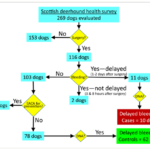2023-02-15 ノースカロライナ州立大学(NCState)
◆人間の免疫系には、適応型と自然型の2つがあります。適応型免疫系には、体が遭遇した病原体を「記憶」するT細胞とB細胞があるが、防御を開始するのが遅く、病原体を検知してから数日(時には数週間)経ってから行動する。
◆自然免疫系は、体の最初の応答者として機能し、数時間以内に侵入した場所に派遣される白血球を含んでいる。この白血球の中には好中球が含まれており、好中球が細胞内で作る微量の漂白剤や過酸化水素のような活性酸素を病原体に直接ぶつけて殺すことができるのである。このプロセスは、呼吸性バーストと呼ばれている。
◆Drakeとその研究チームは、環境に関連する9種類のレガシーPFASと新興PFASが、ゼブラフィッシュ胚の好中球、好中球様細胞(好中球のように振る舞うように化学的に処理できる細胞)、ドナー血液から培養したヒト好中球に及ぼす影響について調べた。
◆新興PFASとは、GenXのように、毒性が証明された旧来のレガシーPFASに代わるものとして開発された化学物質です。この研究に含まれるすべてのPFASは、ケープ・フィア川と、ケープ・フィア川を飲料水とする住民の血清の両方から検出されました。
◆試験した9種類のPFASのうち,GenXのみが胚性ゼブラフィッシュ,好中球様細胞およびヒト好中球における好中球呼吸バーストを抑制した。PFHxAもまた、呼吸バーストを抑制したが、胚性ゼブラフィッシュと好中球様細胞においてのみであった。
◆このため、細胞株では高用量による毒性作用が見られると言えますが、長期間の暴露が最終的に免疫系にどのような影響を及ぼすかはまだ分かりません」。この論文で終わりというわけではなく、最初の一歩です。私たちの研究が、これら2つの化学物質のさらなる研究の優先順位付けに役立つことを期待しています。
<関連情報>
- https://news.ncsu.edu/2023/02/pfas-can-suppress-white-blood-cells-ability-to-destroy-invaders/
- https://www.tandfonline.com/doi/full/10.1080/1547691X.2023.2176953
レガシーおよび新興のパーおよびポリフルオロアルキル物質が好中球の呼吸バーストを抑制すること Legacy and emerging per- and polyfluoroalkyl substances suppress the neutrophil respiratory burst
Drake W. Phelps,Anika I. Palekar,Haleigh E. Conley,Giuliano Ferrero,Jacob H. Driggers,Keith E. Linder,Seth W. Kullman,David M. Reif,M. Katie Sheats,Jamie C. DeWitt & Jeffrey A. Yoder
Journal of Immunotoxicology Published:14 Feb 2023
DOI:https://doi.org/10.1080/1547691X.2023.2176953

Abstract
Per- and polyfluoroalkyl substances (PFASs) are used in a multitude of processes and products, including nonstick coatings, food wrappers, and fire-fighting foams. These chemicals are environmentally-persistent, ubiquitous, and can be detected in the serum of 98% of Americans. Despite evidence that PFASs alter adaptive immunity, few studies have investigated their effects on innate immunity. The report here presents results of studies that investigated the impact of nine environmentally-relevant PFASs [e.g. perfluorooctanoic acid (PFOA), perfluorooctane sulfonic acid potassium salt (PFOS-K), perfluorononanoic acid (PFNA), perfluorohexanoic acid (PFHxA), perfluorohexane sulfonic acid (PFHxS), perfluorobutane sulfonic acid (PFBS), ammonium perfluoro(2-methyl-3-oxahexanoate) (GenX), 7H-perfluoro-4-methyl-3,6-dioxa-octane sulfonic acid (Nafion byproduct 2), and perfluoromethoxyacetic acid sodium salt (PFMOAA-Na)] on one component of the innate immune response, the neutrophil respiratory burst. The respiratory burst is a key innate immune process by which microbicidal reactive oxygen species (ROS) are rapidly induced by neutrophils in response to pathogens; defects in the respiratory burst can increase susceptibility to infection. The study here utilized larval zebrafish, a human neutrophil-like cell line, and primary human neutrophils to ascertain whether PFAS exposure inhibits ROS production in the respiratory burst. It was observed that exposure to PFHxA and GenX suppresses the respiratory burst in zebrafish larvae and a human neutrophil-like cell line. GenX also suppressed the respiratory burst in primary human neutrophils. This report is the first to demonstrate that these PFASs suppress neutrophil function and support the utility of employing zebrafish larvae and a human cell line as screening tools to identify chemicals that may suppress human immune function.


